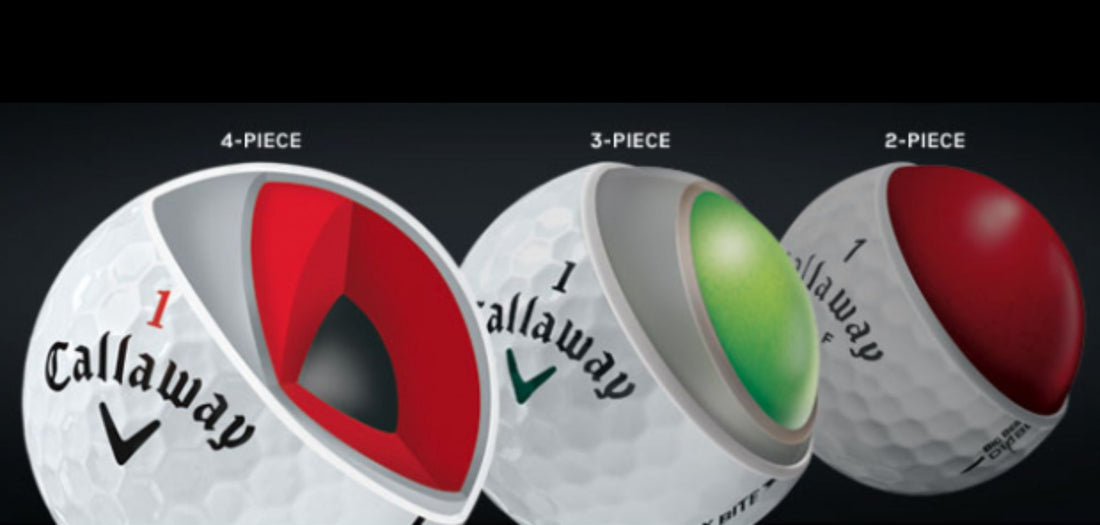
Golf Balls: Which One Should You Buy and Why?
Share
Golf Balls: Which One Should You Buy?
When it comes to improving your game, the type of golf ball you choose can make a significant difference. Not all golf balls are created equal, and understanding their differences can help you make the right choice for your skill level, playing style, and budget. In this guide, we’ll break down the key differences between various types of golf balls and help you decide which one is best for you.
- Understanding Golf Ball Construction
Golf balls may all look similar, but their construction can vary significantly, influencing how they perform on the course. The construction of a golf ball generally consists of several layers, each designed to optimize specific aspects of performance such as distance, spin, and control. Here’s a closer look at the most common types of golf ball construction:
- Two-Piece Golf Balls:
Two-piece golf balls are the simplest in design, consisting of a solid core and a durable outer cover. The core is typically made of a high-energy rubber or similar material that is designed to maximize distance by promoting high ball speeds. The cover is often made of a tough material like Surlyn, which is resistant to cuts and scratches, providing excellent durability.
Who Should Use Them? Two-piece golf balls are ideal for beginners, high-handicap golfers, or those with slower swing speeds. They offer maximum distance with minimal effort, making them easier to hit straight. The durable cover also makes them a good choice for golfers who are prone to losing balls, as they’re more cost-effective.
- Three-Piece Golf Balls:
Three-piece golf balls add a layer of sophistication by introducing a mantle layer between the core and the cover. This layer is usually made of a softer material, which helps to increase spin and control, especially on approach shots and around the greens. The core is typically softer than that of a two-piece ball, which can offer a better feel.
Who Should Use Them? Three-piece balls are well-suited for mid-handicap golfers who have developed some consistency in their swing and are looking for a balance between distance and control. These balls provide better spin control on iron shots and more feedback on the greens, making them a good choice for players looking to improve their short game.
- Four-Piece Golf Balls:
Four-piece golf balls take things a step further by adding an additional layer, typically to optimize spin separation. This means the ball can offer low spin off the driver (for distance) and high spin with short irons (for control). The extra layer helps to transfer energy from the clubface to the core more efficiently, resulting in higher ball speeds and better performance on different types of shots.
Who Should Use Them? These balls are designed for lower-handicap golfers who want to fine-tune their game. They offer exceptional control, particularly on approach shots and around the greens, while still providing the distance needed off the tee. The added layers offer a more sophisticated feel and spin characteristics that can help skilled players shape their shots more effectively.
- Five-Piece Golf Balls:
Five-piece golf balls represent the pinnacle of golf ball technology, with each layer serving a specific purpose to enhance performance. These balls typically feature a soft outer cover for excellent greenside control, multiple mantle layers for spin management, and a core designed for maximum energy transfer and distance.
Who Should Use Them? Five-piece balls are typically used by professional golfers or highly skilled amateurs who can consistently benefit from the subtle differences each layer provides. They offer the best of all worlds—maximum distance, optimal spin control, and exceptional feel. However, these balls are the most expensive and require a high level of skill to fully appreciate their benefits.
- Compression Levels
Compression refers to how much the golf ball deforms when hit. The compression level can influence the feel and performance of the ball:
- Low Compression (70-80): These balls are softer and compress more on impact. They are ideal for players with slower swing speeds (under 85 mph) because they maximize distance even at lower speeds. They also tend to feel softer.
- Mid Compression (80-90): These are a good all-around option for players with medium swing speeds (85-100 mph). They offer a balance between distance and control.
- High Compression (90-100+): These balls are harder and better suited for players with fast swing speeds (over 100 mph). They provide more control and accuracy, especially on the greens.
- Spin Rates
The amount of spin a golf ball generates can affect its trajectory and behavior on the green:
- Low Spin: These balls are designed to reduce side spin, helping to keep shots straighter. They’re great for beginners who struggle with slicing or hooking the ball.
- Mid Spin: These offer a balance between distance and control, suitable for a wide range of players. They provide moderate spin on the green without sacrificing too much distance.
- High Spin: These balls offer maximum control and are ideal for skilled players who can manipulate spin to their advantage. High-spin balls can stop quickly on the greens but require a good level of skill to control.
- Cover Material
The outer layer of the golf ball can be made from different materials, which affects durability, feel, and spin:
- Surlyn: A durable, less expensive material often used in two-piece balls. It provides a firmer feel and more distance but less spin and control on the greens.
- Urethane: A softer, more expensive material used in multi-layered balls. Urethane covers offer better control and spin, making them a favorite among low-handicap players.
- Price Range
Golf balls can range from very affordable to quite expensive, depending on their construction and brand:
- Budget-Friendly ($15-$30 per dozen): Two-piece balls like the Titleist TruFeel or Callaway Supersoft are great for beginners or casual players looking for distance and durability without breaking the bank.
- Mid-Range ($30-$45 per dozen): Balls like the Srixon Q-Star Tour or TaylorMade Tour Response offer a good balance of performance and value, making them ideal for intermediate players.
- Premium ($45-$60+ per dozen): High-end balls like the Titleist Pro V1 or Bridgestone Tour B XS are designed for advanced players who demand the best in feel, spin, and control.
- Choosing the Right Golf Ball for You
- Beginners: Look for a two-piece ball with low compression and low spin. This will help you gain more distance and keep the ball straighter. Budget-friendly options like the Callaway Supersoft or Wilson Ultra are excellent choices.
- Intermediate Players: As you improve, you may want to explore mid-compression, multi-layered balls that offer a balance between distance and control. Consider the Srixon Q-Star Tour or the TaylorMade Tour Response.
- Advanced Players: If you have a fast swing speed and are confident in your ability to control the ball, a premium, high-compression ball with a urethane cover will give you the best performance. The Titleist Pro V1 or Bridgestone Tour B XS are top picks in this category.
- Testing and Personal Preference
Finally, remember that the best way to find the perfect golf ball is through trial and error. Purchase a few sleeves of different balls and test them on the course. Pay attention to how they feel, how they perform in different conditions, and which ones give you the best results.
Conclusion
Choosing the right golf ball can significantly enhance your performance on the course. Whether you're a beginner looking for more distance, an intermediate player seeking a balance of control and power, or an advanced golfer who demands precision, there's a ball out there that’s perfect for you. Understanding the differences in construction, compression, spin rates, and cover material will help you make an informed decision, so you can play your best game every time you step on the course.
